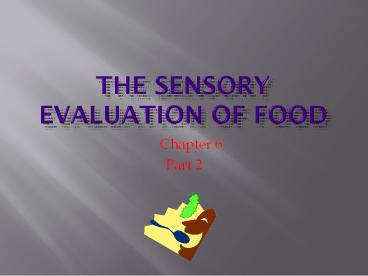The Sensory Evaluation of Food - PowerPoint PPT Presentation
1 / 17
Title:
The Sensory Evaluation of Food
Description:
Food budget buy ... New packaging and preservation methods What are ... and walls of the pharynx contain receptor cells called taste cells Four Types of Taste ... – PowerPoint PPT presentation
Number of Views:585
Avg rating:3.0/5.0
Title: The Sensory Evaluation of Food
1
The Sensory Evaluation of Food
- Chapter 6
- Part 2
2
What InfluencesFood Choices?
- Culture and Geography
- Emotions and Psychology
- Beliefs
- Health Concerns
- Appearance
- Taste and Odor
3
Other Influences
- Food Costs
- Price plays some role in determining what people
eat. - Food budget
- buy every product you want
- choose a less costly substitute
- rule out a food altogether
4
- Technology
- Increased the number of people who have access to
some foods. - New packaging and preservation methods
- What are some of the products at the supermarket?
- Can you name a few?
5
The Flavor Factor
- The Role of Temperature
- Food may taste different depending on its
temperature. - Heat increases the sweet taste of some sugars.
- Salty tastes are more intense in cooler foods.
- Odor affects taste
- Cold numbs tongue, makes food seem tasteless
until warmed
6
- Texture
- Sensory evaluators test food for textural aspects
- Brittleness
- Graininess
- Chewiness
7
- Mouthfeel
- What is this?
- How a food feels in the mouth.
- Associated with quality of foods
- Premium ice cream feels smooth not gritty
- Tender steak melts in the mouth
- Affected by temperature
8
- Sound
- Texture cannot be separated from its sound
- Ex applesauce should be smooth and not have a
crunchy sound - Crackers should crackle
9
The Sensory System
10
- http//www.youtube.com/watch?vj7GibFhuBmE
11
Five Senses
Structure and Function
The sensory system includes any organ or part
involved in the perceiving and receiving of
stimuli.
sight
taste
Five Senses
smell
hearing
touch
All sensory organs contain specialized receptor
cells that receive stimuli.
12
Sight-the Eye
Structure and Function
eyebrow
Sight-the Eye
- Contains about 70 of all the receptors in the
body - Each eye is a sphere consisting of three layers
- -outer layer (eyelid)
- -middle layer (vascular layer)
- -interior layer (retinal layer)
eyelashes
Note Eyebrows and eyelashes keep foreign
particles from entering the eye.
13
The Skin Receptors
Structure and Function
Touch, Pain, and Temperature the Skin
Skin receptors can sense the following
14
The Nose
Structure and Function
Smell - the Nose
The sense of smell is activated by neurons called
olfactory receptors which are covered with cilia.
Olfactory receptors are yellowish-brown masses
along the top of the nasal cavity.
15
Taste
Structure and Function
Taste - the Tongue and Oral Cavity
.. ...
- Taste Buds
- organs that sense the taste of food
- located on the surface of the tongue, roof of
mouth, and walls of the pharynx - contain receptor cells called taste cells
...
Four Types of Taste Buds
- sweet
- salty
- bitter
- sour
16
(No Transcript)
17
- Why is sensory evaluation used by food producers?
- What is the difference between flavor and taste?
- Why might hot cocoa smell more chocolatey than
chocolate ice cream? - Why is a foods sound considered an element of
texture?

